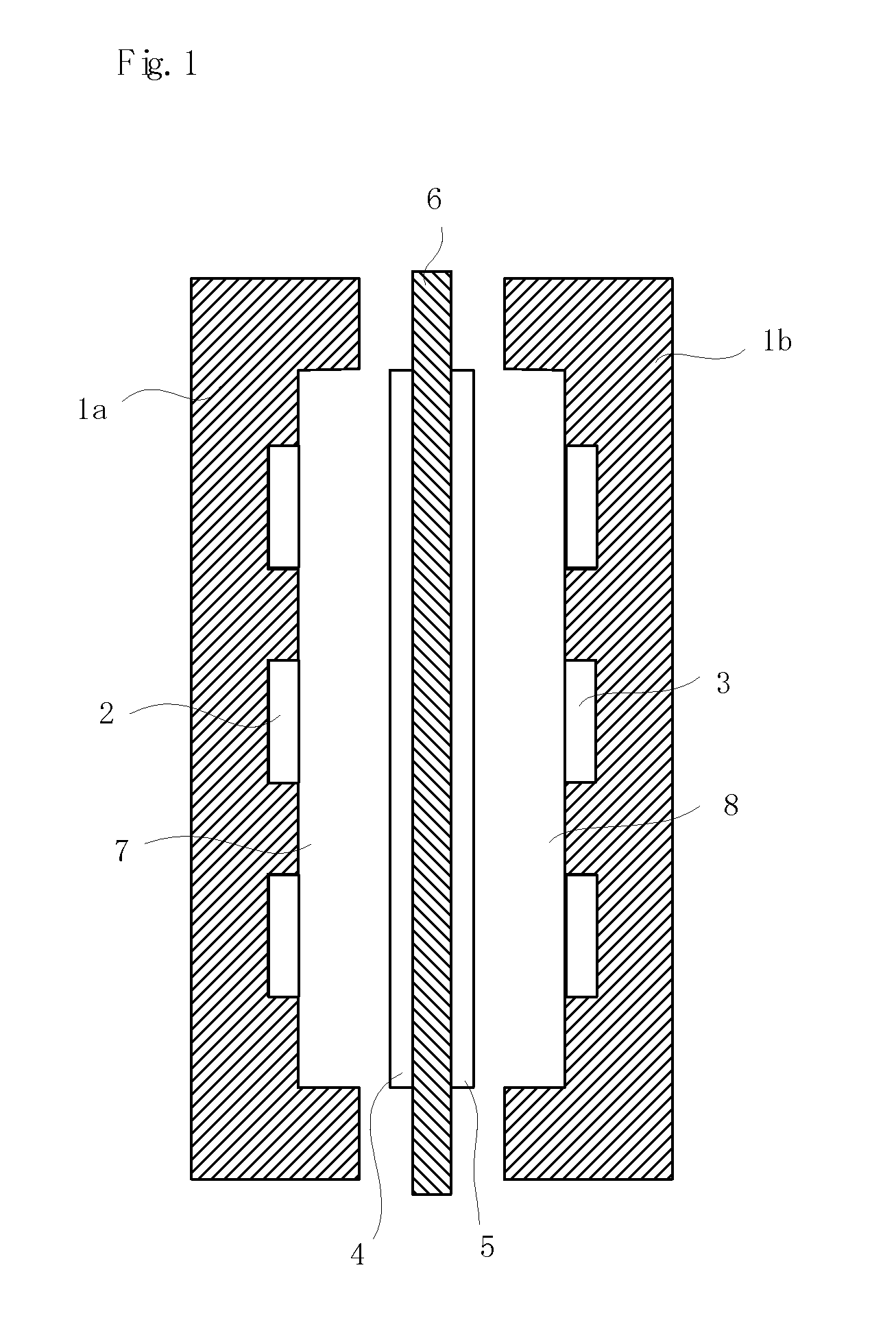Separating membrane for fuel cell
a fuel cell and membrane technology, applied in the field of membranes for fuel cells, can solve the problems of high fuel cell output reduction, polymer poisoning of catalysts, etc., and achieve the effect of large molecular weight and high outpu
- Summary
- Abstract
- Description
- Claims
- Application Information
AI Technical Summary
Benefits of technology
Problems solved by technology
Method used
Image
Examples
production example 1
[0167]There was prepared a monomer composition consisting of 100 parts by mass of styrene, 10 parts by mass (8.0 mole % in total polymerizing monomers) of divinylbenzene and 5 parts by mass of tert-butyl peroxyethylhexanoate. Therein was immersed, at atmospheric pressure at 25° C. for 10 minutes, a porous membrane (thickness: 25 μm, porosity: 37%, average pore diameter: 0.03 μm) made of a polyethylene (PE, weight-average molecular weight: 250,000), to impregnate the porous membrane with the monomer composition.
[0168]The porous membrane was taken out of the monomer composition and covered at the both sides with a 100-μm polyester film (a peeling material). Then, thermal polymerization was conducted under nitrogen pressure of 0.3 MPa at 80° C. for 5 hours.
[0169]The resulting filmy material was immersed, at 40° C. for 45 minutes, in a 1:1 mixture of 98% concentrated sulfuric acid and chlorosulfonic acid (purity: 90% or more), to obtain a sulfonic acid type cation exchange membrane. The...
production examples 2 to 4
[0170]Cation exchange membranes were obtained in the same manner as in Production Example 1 except that the monomer composition and porous membrane of Production Example 1 were changed to those shown in Table 1. The cation exchange membranes were measured for ion exchange capacity, water content, membrane resistance and membrane thickness. The results are shown in Table 2.
production example 5
[0171]The cation exchange membrane of Production Example 1 was dried at room temperature for 24 hours. Then, the dried cation exchange membrane was immersed, at room temperature for 30 minutes, in a monomer composition consisting of 100 parts by mass of 4-vinylpyridine, 80 parts by mass (39.0 mole % in total polymerizing monomers) of divinylbenzene, 5 parts by mass of tert-butyl peroxyethylhexanoate, 900 parts by mass of toluene and 200 parts by mass of pyridine.
[0172]The ion exchange membrane was taken out of the monomer composition and covered at the both sides with a 100-μm polyester film (a peeling material). Then, thermal polymerization was conducted under nitrogen pressure of 0.3 MPa at 80° C. for 5 hours. The resulting polymerization product was immersed in methanol for 2 hours to obtain a cation exchange membrane having also an anion exchange group.
[0173]The above cation exchange membrane was measured for cation exchange capacity, water content, membrane resistance and membr...
PUM
| Property | Measurement | Unit |
|---|---|---|
| thickness | aaaaa | aaaaa |
| size | aaaaa | aaaaa |
| pore diameter | aaaaa | aaaaa |
Abstract
Description
Claims
Application Information
 Login to View More
Login to View More - R&D
- Intellectual Property
- Life Sciences
- Materials
- Tech Scout
- Unparalleled Data Quality
- Higher Quality Content
- 60% Fewer Hallucinations
Browse by: Latest US Patents, China's latest patents, Technical Efficacy Thesaurus, Application Domain, Technology Topic, Popular Technical Reports.
© 2025 PatSnap. All rights reserved.Legal|Privacy policy|Modern Slavery Act Transparency Statement|Sitemap|About US| Contact US: help@patsnap.com


